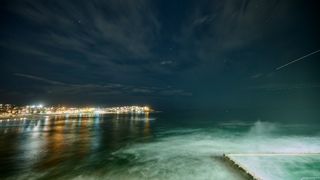Meteor brightens up the sky above Sydney as peak meteor showers arrive
Keep looking up! This month will be full of shooting stars.

The peak shooting star season has arrived with six meteor showers expected to pepper Earth in the upcoming weeks as the planet hurtles through fields of cometary debris.
The image above captures a meteor illuminating the night sky above Sydney, Australia, on the night of July 28. With the view of the southern sky, Australians will be able to enjoy the Piscis Austrinids, the Southern Delta Aquariid meteor shower, and the Alpha Capricornids meteor showers in the first week of August in addition to the famed Perseids, which will peak in the middle of the month.
This year's Perseids, however, will be rather spoiled as the peak will coincide with the full moon, which means only the brightest meteors will be visible in the lighter than usual sky.
Related: A potential new meteor shower from shattered comet has scientists excited
According to Space.com's sky-watching columnist Joe Rao, the other five shooting star displays in August will enjoy a much darker sky, taking place closer to the new moon.
The Alpha Capricornids, which peaked earlier this week, are a rather diffuse shower, with only a few meteors hitting Earth's atmosphere every hour. The display is named after the constellation Capricorn, from which it appears to emanate.
The Piscis Austrinids, mostly visible from the Southern Hemisphere, originate in the constellation Pisces. This shower is also relatively sparse, at about eight meteors per hour.
Get the Space.com Newsletter
Breaking space news, the latest updates on rocket launches, skywatching events and more!
The Delta Aquarids, which appear to arrive from the constellation Aquarius, are a slightly denser meteor shower with a few dozen shooting stars expected during the peak nights around July 30.
The Iota Aquariids shower comes just before the Perseids and peaks around Aug. 6, just before the waxing moon will start spoiling the observations. The shower is quite thin, with less than ten meteors expected every hour.
The famous Perseids usually deliver more than 60 meteors per hour. Just how many will be visible this year remains a question as the peak of the shower (Aug. 11 to 13) coincides with the August full moon.
The final shower of the summer will be the Kappa Cygnids, peaking on Aug. 17, which although very sparse, sometimes delivers exceptionally spectacular flaring fireballs.
If you want advice on how to photograph meteor showers, check out our how to photograph meteors and meteor showers guide and if you need imaging gear, consider our best cameras for astrophotography and best lenses for astrophotography.
And if you capture a particularly spectacular shooting star, send us your image at spacephotos@space.com.
Follow Tereza Pultarova on Twitter @TerezaPultarova. Follow us on Twitter @Spacedotcom and on Facebook.
Join our Space Forums to keep talking space on the latest missions, night sky and more! And if you have a news tip, correction or comment, let us know at: community@space.com.

Tereza is a London-based science and technology journalist, aspiring fiction writer and amateur gymnast. Originally from Prague, the Czech Republic, she spent the first seven years of her career working as a reporter, script-writer and presenter for various TV programmes of the Czech Public Service Television. She later took a career break to pursue further education and added a Master's in Science from the International Space University, France, to her Bachelor's in Journalism and Master's in Cultural Anthropology from Prague's Charles University. She worked as a reporter at the Engineering and Technology magazine, freelanced for a range of publications including Live Science, Space.com, Professional Engineering, Via Satellite and Space News and served as a maternity cover science editor at the European Space Agency.
